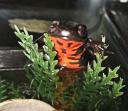 What happens when you release a fire-bellied toad into the wild?
What happens when you release a fire-bellied toad into the wild?
DISASTER!
Fire-bellied toads are not native to most of the world. Oriental fire-bellied toads are found in the wild in parts of Northeastern China, Southeastern Siberia, Korea and the Tsushima and Kyushu islands of Japan.
That cute little toad you have in your home as a pet most likely was born at a toad farm and not in the wild. It has never been in the wild and should never be in the wild.
If you grow tired of taking care of your fire-bellied toad (or any critter that is not native to your area) find a good home for it. Or, take it to a pet store and ask them to find a good home for it. Many pet stores will take pets in and adopt them out to another good home. This goes for fish also. If a fish gets too big for your tank or you need to get rid of it for some reason a fish store will take it in. Owners of pet stores realize that it is in their best interest to take in these creatures rather than have them released into the wild and hurt the native habitat.
If you released your fire-bellied toad into the wild the native animals that live in your area would be negatively affected. Whole ecosystems have been changed because of people introducing non-native animals into areas. A good example is the cane toad that was introduced into Australia in 1935 and have been raising havoc ever since. Check out the complete story at: http://www.fdrproject.org/pages/toads.htm
The cane toad is highly poisonous but it seems this was not taken into account when authorities decided to use them to get rid of cane beetles in the sugar cane fields in Gordonvale, Australia. After being introduced into Australia in hopes that they would take care of this pest problem (which the toads never did take care of) the cane toad continued to flourish because it had no natural predators. Almost all of Australia is now overrun with large, poisonous cane toads.
All stages of a cane toad’s life they are poisonous. They have no natural predators to keep their numbers under control. There is evidence that they may be eating Australia’s frog population. Fish who eat toadpoles die. Animals who eat adults die. Snakes have been found killed by toad toxin so fast that the toad is still in their mouth. Small amounts of water such as a pet’s water dish can be fouled by the toad’s poison and the pet will become sick from drinking out of it.
The pests have spread across most of Queensland, the Northern Territory into the wetlands of Kakadu. They have hitched a ride to Sydney in vegetable trucks and now are entering the native habitat of the already endangered Green and Golden Bell frog.
All of this havoc is now reducing many species of Australia wildlife even crocodiles!
No one thought when a little over 100 cane toads were released into a few sugar cane fields in a very small area to eat cane beetles that the whole of Australia’s ecosystem would be negatively affected and that effect would reach the crocodile population.
Let’s use more of our common sense than these “intelligent” authorities did in Australia and NEVER, NEVER, NEVER release your fire-bellied toad into the wild.
Kind Regards,
Greenie, Brownie & Limey
 Limey, Brownie & Greenie
Limey, Brownie & Greenie
P.S. That goes for fire-bellied newts also.  Randal 1 and Randal 2
Randal 1 and Randal 2
Filed under: Fire-Bellied Toads | Tagged: amphibians, australia, bell frog, cane, cane beetle, cane toad, china, crocodile, eco system, ecosystem, fire belly toads, Fire-Bellied Toads, frogs, gordonvale australia, green frog, habitat, kakadu, korea, native, northern territory, pest, poisonous, queensland, release, sibera, sugar cane, sydney, toads, wild, wildlife |


The pet store will NOT take back my firebelly toads!!!! They were very clear about that..nor will they adopt them out. The wildlife museum will not take a domestic toad. I cannot give them to my students to take home for the summer because of the salmonila (sp) factor, and all the live crickets it requires to feed them. I no longer can afford crickets and the gas to the pet store weekly. This is a dilema… I cannot keep them in my apartment because my cats go nuts and the crickets get out…hide and grow big and noisy at night…and of course they hide out for months on end.
Hi April,
Sorry to hear about your inability to find someone to take your firebelly toads. If you lived in Texas close to me I would take them off your hands.
It sounds cruel but it would be better to put them to sleep than release them in the wild.
My idea (and it is only MY idea not anything from professionals) would be to put them to sleep slowly and peacefully. To do so you could put them in a freezer bag and place them in the freezer for about a day. You can then take care of their remains anyway you wish. My sister did this with regular toads when she had a hog-nosed snake so she would feed it in the winter time. (Hog-nosed snakes are one of the few snakes that actually love toads and toads are almost all they eat.) She knew she would never find toads in the winter time so had to freeze them and thaw them out to feed to her snake in the winter.